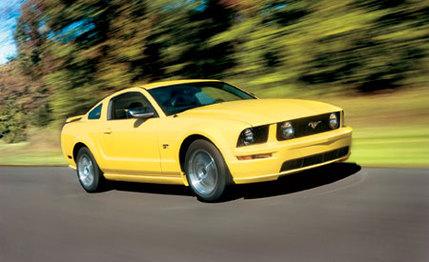
 Road Test
Road Test
It doesn't happen often, but the hens in the henhouse sometimes kill the fox. That's apparently what happened over at Henry's glass henhouse in Dearborn.
Of the 2005 Mustang's myriad upgrades, none is more significant than its new foundation. At last, the Fox platform, which wasn't all that impressive even when it debuted on the retarded Fairmont in 1978, has been let out to pasture, where we can only hope it contracts hoof-and-mouth while in the clutches of an illegal leg trap. The Mustang now rides on a heavily modified version of the Lincoln LS and Jag S-type platform. Unlike those luxo-cruisers, America's favorite pony car retains its blue-collar solid rear axle. But now it's a three-link coil-over layout, abetted by a tubular Panhard rod.
The new platform ushers in a 5.8-inch increase in wheelbase, which has worked wonders on ride and tracking. Length is up by 4.8 inches, but height and width grow little. To the naked eye, the new Mustang appears no larger than its predecessor, although it is 215 pounds more porcine.
The less obvious upgrade resides underhood. The GT's 4.6-liter SOHC modular V-8 now features 24 valves rather than 16. The three-valve heads permit an increase of 40 horses and 18 pound-feet of torque, although both improvements are realized at loftier revolutions.
Climb inside our Screaming Yellow test car, and what you notice first is $450 worth of optional aluminum trim running the length of the dash, pockmarked by four retro-looking vents, each 3.5 inches in diameter. They appear to be large enough to ventilate a small industrial-arts classroom. The steering wheel, which is adjustable for rake but not reach, features three chrome-faced spokes so fat they're often in the way. And the gauges are to be found at the bottom of a kind of chrome mineshaft. Peer into this pit, and you'll locate a large 8000-rpm tach and 140-mph speedo, whose increments, most critically in the 40-to-60-mph range, are too coarse to calculate quickly. Squeezed in between are gauges for fuel, water temp, volts, and oil level.
Apart from the brightwork, the interior is otherwise as black as an eel's esophagus, ridiculously funereal for a car whose four-decade reputation has been built on smiles and suspended drivers' licenses.
The swollen wheelbase has also allowed a slight increase in interior volume—an extra three cubic feet fore, one cubic foot aft. The cockpit now feels a lot less claustrophobic, and the fixed portholes in the flying buttresses introduce daylight farther astern, a benefit to the still-tormented rear riders, who had better not make the mistake of being taller than five foot ten. The rear seatbacks fold flat, revealing a pass-through 12 inches high and 40 inches wide, and the trunk grows by two cubic feet, too. Fact is, the cargo-carrying capacity is quite good.
The driver's seat is, uh, firm, and the adjustable lumbar support feels like a pine bough that's perambulating your spinal regions. But lateral support is okay, and a two-hour driving stint induced no incurable spasms. More important, the relationship among seat, pedals, and steering wheel has been improved. You no longer feel as if you're sitting on a bar stool. The brake and throttle pedals could be closer to facilitate heel-and-toeing, but you soon learn to compensate.
Throttle tip-in is more gentle and predictable. There's still some minor clutch slipping required for first-gear starts, but you can now floor the throttle at 5 mph, then suddenly jump out of it completely without inducing transmission windup. As with all of Ford's modular V-8s, power delivery is refined, and you can unwittingly cruise for ages with the engine spinning at big revs. But you soon learn that the real power manifests up high, in the 4000-to-redline range. Gone are the days of pushrod power gushing forth at step-off.